
Green greetings to you all. Time to spring up in colors! Time to inhale the green.
Look up! Look up. The trees are blooming. Check them out. Not just the showy ones, like cherries and crabapples, beautiful as they are. Take the time to notice the flowers of the hardwood trees around you. One of the prettiest of the wild, flowering spring trees is the red maple. We are so happy to catch the fine photo of her on the next page.
It is still great sugaring weather, with nights below freezing and days warm and sunny, so maples are on our minds. They, like everything else, are responding to the lengthening days. Way back in the beginning of February, on Ground Hog Day or the Day of the Feast of Flames, we noticed the buds that are now flowers slowly beginning to stir, to feel the sap rising.
After you look up, look down. All the lily family plants – crocus, tulip, daffodil, wild onions, iris, snowdrops – with petals in threes – are spearing through the leaves of last autumn and spreading colorful cheer. Here's some from my garden.
And here's a little picture gallery with two other plants that caught my eye this week: (in addition to the maple flowers). First, the medicinal, evergreen, goldthread. And then a stunning yellow flower in the buttercup family. Not only are the individual flowers stunning, the group of them covers nearly a quarter of an acre and that is quite the sight. Like all buttercups, it is shiny, and so pretty in the spring light.
I am just finishing up my quarterly article for Plant Healer Magazine on the Medicine Wheel of Plant Uses. And welcoming the first of the year's apprentices, as well as the first of this year's nettle. (There is a connection.)
Look up! Look down! Green blessings are everywhere.
Goldthread (Coptis trifolia)
Looking a little like a wayward, wet-footed, strawberry, the evergreen goldthread is a tiny medicinal plant of the Northeast woodlands. Also known as yellowroot (what else?!) or cankerroot (we will get to that), this coptis is named for its thread-like yellow root, which you can see in my photo. (I ate that entire plant, root and all, in thanks for its allowing me to pull it and photograph it for you.) The yellow coloration indicates the presence of berberine, an antibacterial substance that is especially effective against HPV and other venereal warts, also known as cankers. Goldthread root tea is generally used externally on mucus surfaces of the genital, mouth, and eyes to kill bacteria, counteract swelling, and strengthen the tissues against reinfection. Her Chinese sister,
Coptis, is a very important medicine.
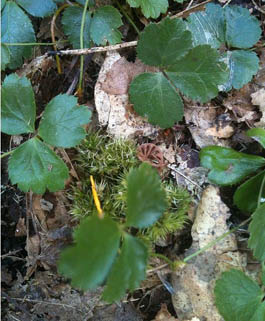 Red Maple Flowers
Red Maple Flowers
Look up and enjoy the fascinating flowers of the deciduous trees. If you see a haze of red, you have found a red maple. Their sap is not sweet enough to be used for sugaring, but their flowers are perfectly edible. We add them to store-bought greens for a rush of wild. In Oregon, I was served them battered and fried. Tempura anything is good, and tempura red maple flowers is divine. The early tree flowers provide an important first food for the bees, who are just coming out to fly and are very (very!) hungry.
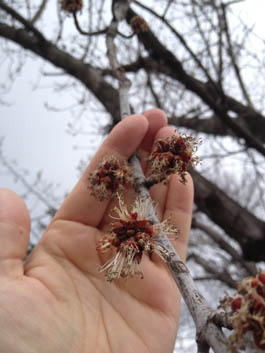 Globe flower (Trollius laxus)
Globe flower (Trollius laxus)
A beautiful spring shout of buttercup yellow! I wish you could see her en mass, covering a huge swath of ground, from the trash-littered road side up to the edge of the lawn, and thence almost into the forest. She is gold spilled upon the drab leaves of the forest floor and shining through the debris that emerges as winter's snow melts away. She is probably, like her buttercup sisters, poisonous, but I should like to sit with her a spell and see what she has to say.
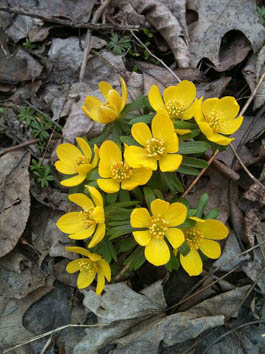
Evergreen Oil recipe
There are so many uses for an antiseptic, antibacterial, anti-tumor oil.
Collect needles and twigs of any aromatic evergreen: cedar, juniper, hemlock, spruce, pine. You will also need a bone dry jar, some olive oil, and a label or two.
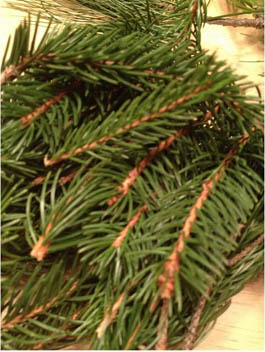
Fill the jar very full of evergreen needles and twigs. You may leave them whole or cut them. Make sure their uppermost tips are well below the top of the jar.
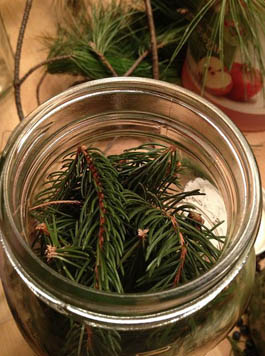
Fill the jar to the top with pure olive oil (or other oil of your choice). It is best if there is a "head" of oil floating over the evergreen. Cap well.
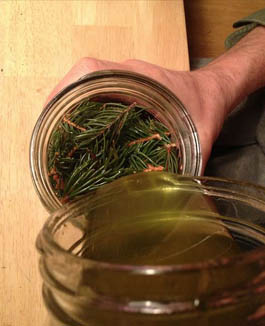
Label, including date, on front and top. Place jar in a bowl to catch overflow. Ready to use in six weeks.
Spring is almost over. Planting begins in earnest. Baby birds are hatching. Frogs are boldly advertising for mates. The sun is warm and stays so long in the sky. And everywhere, every day, something new is springing up.
I had a difficult time choosing just three flowering plants for our photo gallery this week. Each new habitat I visited had new delights to share with you. I finally chose plants growing close to houses; plants that all of you, no matter where you live, can find with little effort, right now, in late spring (for most of us), and even late fall (for those down under). Our three plants this week are: something old (our pal chickweed), something new (dead-nettle), and something borrowed (cuckoo flower). (The something blue is the clear blue sky smiling at you.)
Behind my house is a large (over an acre) depression that floods in the spring. It is a vernal pond. The water stays during the cool spring months, then dries up as summer's heat pours down. But the weeks of its existence, though few, are enough for the frogs and salamanders who depend on these vernal ponds for mating and breeding. It is a special, magical area. Not cuddly or cozy, but filled with the power and presence of trembling life. It reminds me that life makes the best possible use of every habitat, whether that place is to my liking or not.
True, vernal ponds can also be breeding places for insects, including mosquitoes. In my experience, however, they dry up before most insects can make use of them. And I am certain that the insects that the amphibians eat later in the summer more than make up for the few extras that enjoy the vernal pond with us.
Out you go! Into the garden. On a walk. Sitting in the sun. As my dear friend Eaglesong Evans Gardener says: "The best advice my mother ever gave me was 'Go outside and play.'" Yeah! Go outside and play.
Chickweed (Stellaria media)
Here is our old friend chickweed, already blooming. Gather her now. She is a tasty addition to salads and ever so much better than sprouts on sandwiches. Or you could put up some chickweed tincture in case you ever need to dissolve cysts or growths in the ovaries or breasts. Or you could make some chickweed oil; so soothing to tender skin. Or you could make chickweed pesto, but be warned: You could wind up with a chickweed pesto habit!
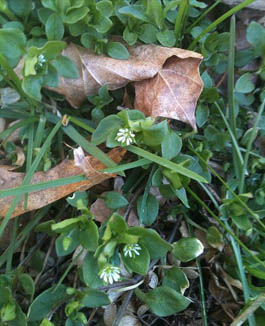 Purple Dead Nettle (Lamiun purpureum)
Purple Dead Nettle (Lamiun purpureum)
Here is the first mint to flower this year. It is a dead nettle, in the dead nettle genus. A rather confusing appellation, as this is clearly not a nettle. Ah, yes. Thus it is "dead" nettle, or "blind" nettle. This genus is the "typical" genus of the mint family and has given its name to the entire family: Lamiaceae. (This replaces the older name Labiatae, which that naughty boy Linnaeus gave to the family. "Labia" is "lips," and the flowers in the mint family are lipped. It was a good name, but it had to be changed to follow the form. The form says the family name must be the same as the name of the typical genus with –aceae added to the end.)
Here's a close up of the flowers. This will help you recognize the shape and structure of mint flowers. Most herbals that mention dead nettle cite the white-flowered species,
Lamiun album. I have no doubt that the purple-flowered one can be used in the same ways: As an astringent, expectorant, antispasmodic, and hemostatic tea that focuses its energies in the belly. It counters profuse menstruation, vaginal discharge, prostate swelling, diarrhea, and intestinal upsets. The tincture of the flowering plant has been used as an aid to sleep. Poultices of the boiled leaves can be used when dealing with gout, varicosities (including hemorrhoids), boils, and bed sores. And, of course, I add it to my spring salads. (Homeopaths use it against sinus congestion, bronchitis, and menstrual pain.)
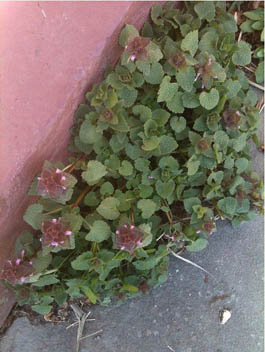
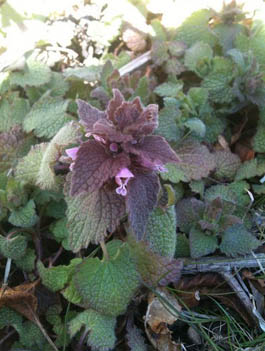 Cuckoo flower (Cardamine pratensis)
Cuckoo flower (Cardamine pratensis)
What a cute name for this tiny little mustard. I always think: "Eat it," but am foiled by its miniscule size. Mustard family plants germinate easily in cool soils and prefer to grow in the cooler weather of late spring and early fall. Wild mustards, like this cuckoo flower, ate popping up everywhere. See if you can find at least one where you live. All parts of most wild mustards are tasty and edible: flowers, seeds, leaves, even the roots, which have a horseradishy taste. If the snow has melted, scratch some dirt this week, no matter how cold it is, and plant some cultivated mustard-family plants like kale, collards, or broccoli. (If the snow melted long ago where you are, I hope you planted your kale way back then.) Green blessings are everywhere.
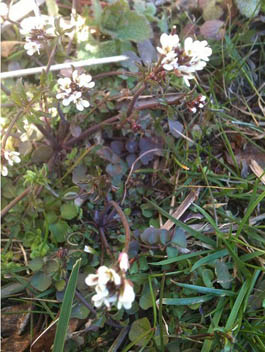
Cedar Smudge
Use it to move energy. Use it to change energy. Use it for protection. Use it for healing.
Please be mindful when playing with fire; it is dangerous.
A. Dry small branches of cedar or juniper until crisp. Place in a heat-proof container and light. After a moment, blow out the flame. The dry needles should smolder and smoke. The smoke is the smudge. Whisk it through the air with a small broom or feathers.
B. Wrap small branches of cedar or juniper with thin string. (Red is traditional.) I wrap in a crisscrossing spiral up and then down the branches. Feel free to invent your own way of wrapping. Be sure to leave a loose end so you can tie the string. Allow to dry. Light. Use as a wand to cast smoke around windows and doors for protection, or to smudge participants in rituals. (Caution for sparks.)

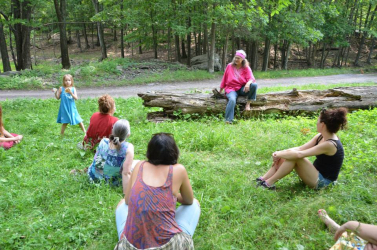 The Wise Woman Center exists to re-weave the healing cloak of the Ancients. This land is sacred, it is a safe space for women, and a place for the teachings of the Wise Woman way. The Goddess lives here, as do goats, fairies, green witches, and elders.
The Wise Woman Center exists to re-weave the healing cloak of the Ancients. This land is sacred, it is a safe space for women, and a place for the teachings of the Wise Woman way. The Goddess lives here, as do goats, fairies, green witches, and elders. Green greetings to you all. Time to spring up in colors! Time to inhale the green.
Green greetings to you all. Time to spring up in colors! Time to inhale the green.
